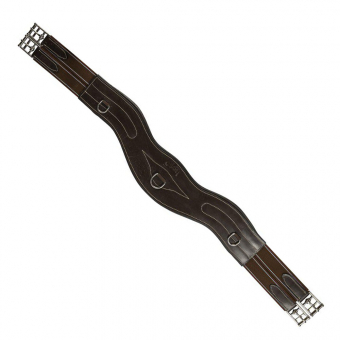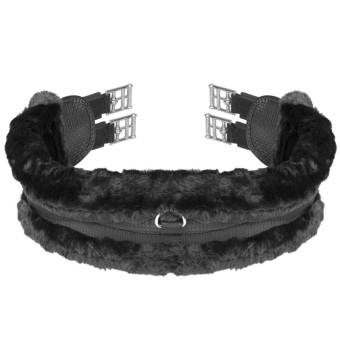A girth serves several important functions besides the most obvious one, which is to keep the saddle in place. It should be chosen with great care, primarily based on its intended use and purpose, but also considering factors such as the horse's anatomy.
Which girth should you choose?
Most people are familiar with the different basic types of girths:- The classic, straight girth.
- Dressage girths, which are short girths adapted to dressage saddles with their long straps.
- And the belly guard girth, or jumping girth as it's also called, which is used as protection in jumping to prevent the horse from hitting its belly with its hooves when clearing obstacles.
- Youth girth: A youth girth is fundamentally like a regular girth but often somewhat narrower, with substantial padding and elasticity on only one side, to prevent over-tightening and provide a better experience for the young horse.
- Anatomical girths: Most girths in the middle and upper segments today take the horse's anatomy into account, but some go the extra mile, often with a wider design around the chest and chest muscles. They often come with a curved shape or exposed sections to minimize interference with the horse's natural movements.
An anatomical girth is the best choice for your horse
As mentioned above, most girths today come in an anatomical and ergonomic design to provide your horse with the best fit and comfort. Whether you're looking for a dressage girth or a jumping girth, you can ensure it sits well, provides plenty of pressure relief, freedom of movement, and doesn't cause chafing or other discomfort by investing in an anatomical girth.The anatomical girth can come in different shapes, and depending on how your horse is built, you should consider the shape of the girth. For a horse with a normal build and normal girth position, a straight girth with cutouts works excellently. However, if you have a horse with the girth position closer to the elbow, an asymmetrical girth may be an option. This girth is only cut out at the elbows but is straight at the back, ensuring a good fit and plenty of room for the legs. For a horse with a shorter back, a larger chest, and/or belly, a forward-curved girth with cutouts for the elbows is the best choice. This design ensures more room for the belly and chest while preventing the girth from sliding forward. For a more athletic anatomy, a similar girth but curved in the opposite direction is optimal. In this case, the backward curve prevents the girth from sliding backward.
Girths with fleece, fluff, and sheepskin
Sheepskin is often found as a detail on many girths and serves a good function in providing a soft contact surface. It's especially beneficial for horses with sensitive skin prone to chafing. Sheepskin today is mostly artificial and goes by various names, from artificial sheepskin to fleece and fluff. Some girths come with fixed or removable fleece, either covering only the sharpest edges where the horse is most likely to chafe or the entire girth for optimal protection. However, loose girth fluff is also available and can be added to any girth. This is usually called a girth tunnel or girth guard and comes in materials other than fleece as well. A brand known for its fully vegan range and products made of artificial leather is Kentucky, which offers a wide selection of high-quality girths.Things to consider when buying a girth
At its core, there are three different materials widely used for girths. Textile is often an affordable option available for regular girths or dressage girths. The other options are leather or synthetic leather, which are available in all models, including belly guard and anatomical girths. These materials often cost more initially but are durable, long-lasting, and of significantly higher quality, giving you a good girth for many years to come and providing excellent comfort for the horse.In addition to the choice of material, it's a good idea to consider what other equipment you may need to use with the girth, as this should also influence your girth selection. Martingales, breastplates, and other types of in-hand and lungeing aids often require attachments to the girth, so to use this type of equipment, you need a girth that offers the possibility for this.
- D-rings: These are often located in three places on the girth, one on each side and one between the front legs, on a jumping girth or regular girth, and only between the front legs on a dressage girth.
- Buckle: This is located in the middle of the belly guard and is preferable for attaching a breastplate because it is very stable.































